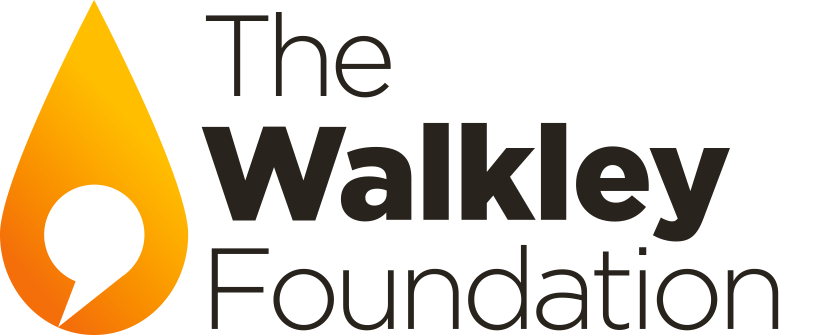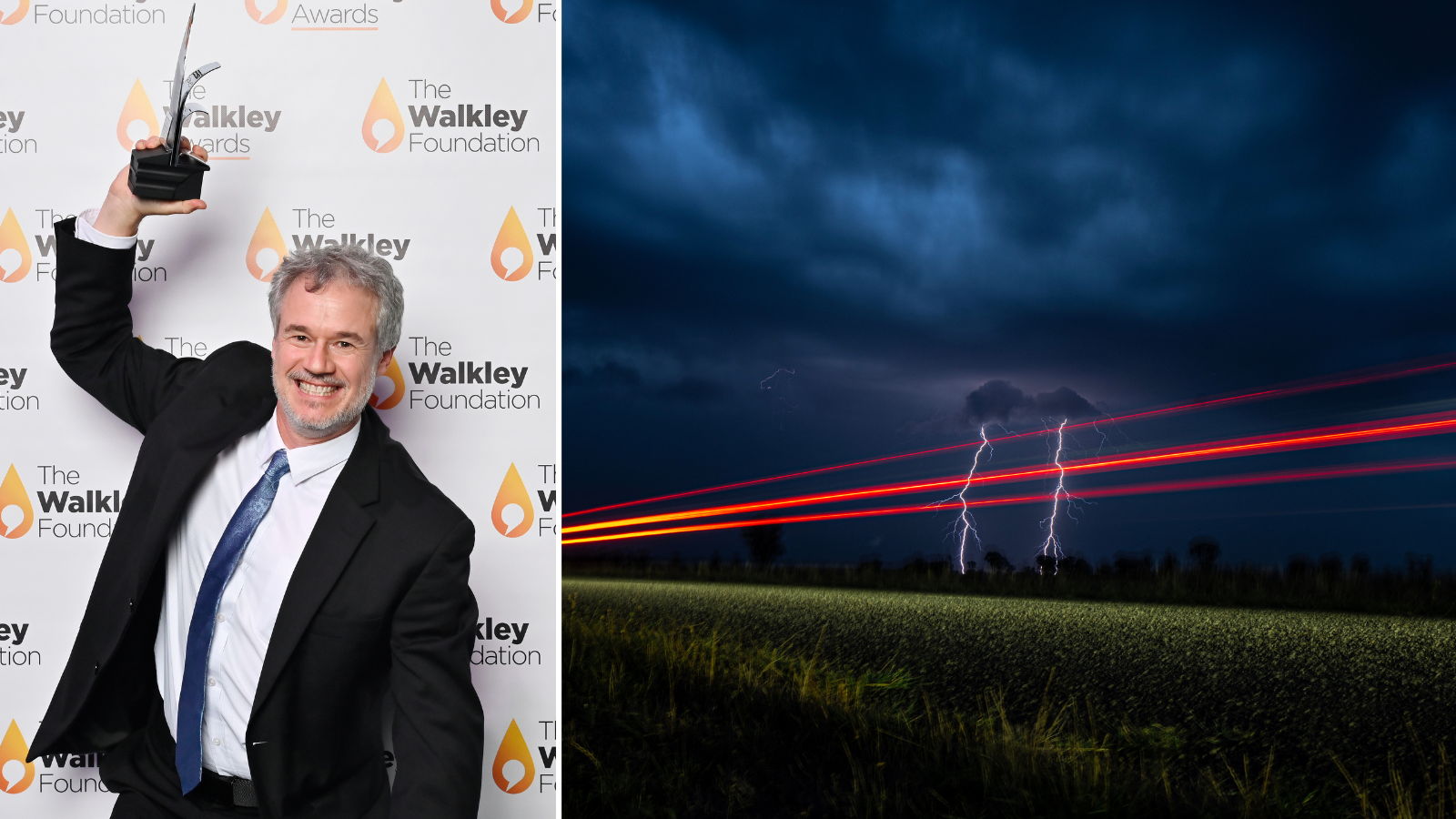By James Gorman
Australian photographer Nick Moir shares his concerns about Australia’s changing weather cycles and his insights about how to make it in the visual media industry after being named Nikon-Walkley Press Photographer of the Year at the 2024 Walkley Awards for his showcase of extreme nature published in the Sydney Morning Herald.
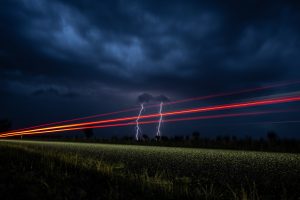
Nick Moir’s winning shot: The Wet West. Despite being in an El-Nino year , after a dry spring NSW had a very wet summer including this violent storm near Nyngan in the state’s west. Photo: Sydney Morning Herald.
James: How many photos do you usually take before you get one that you’re happy with?
Nick: It depends on the job. The things I’m known for, all storm chasing and fires and stuff like that, could be anything from a few hours to a few days, particularly when it comes to storms.
James: Is photojournalism a crucial skill for up-and-coming journalists?
Nick: I believe it is. The Sydney Morning Herald is doing a great job keeping this industry alive. However, it is suffering and unnecessarily dying in Australia. There are not a lot of young photojournalists coming through, because it is so difficult and many can’t afford to do it. A lot of our talented photographers are being forced overseas where they have won Pulitzers [like Daniel Berehulak]. The world has become more and more visual, and images can cross language boundaries, but I think there is a lack of education in how to interpret news visual journalism.
James: What is the most dangerous or precarious place you have ever put yourself in as a photographer?
Nick: I know what I’m doing on these jobs. So, for me, while there can be great risk, it is mitigated. But when you are working with a fire, a tornado or a cyclone, if you screw up, you can die. The most important thing is the training, particularly now with fire. I am fortunate that I am now a qualified firefighter so the risk is mitigated. I know what to do. I would say probably the most precarious stuff was actually during the Canberra fires when I got myself into some situations where the fire was going to burn over me, and I didn’t have the experience or training to avoid it. I’m now very comfortable around storms and fires, but I won’t put myself into a situation that I think is unnecessarily dangerous. But at the end of the day, there are things you can’t prepare for.
James: When did you realise you wanted to be a photographer?
Nick: I was delivering mail in 1993 at the Sydney Morning Herald as a mailroom assistant and went around to photographics and realised that this is where things were happening and the stories were being told. It was an exciting job, and I wanted to do that. I wholeheartedly threw myself into it. My father is Alan Moir the cartoonist, so l find being able to mix art and media together — there are only a few places where you do that. Cartooning is one, and journalism is the other.
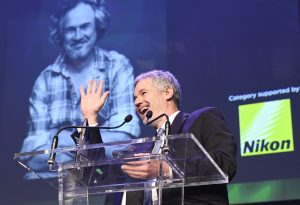
Nick Moir winning the coveted Nikon-Walkley Press Photographer of the Year award at the 2024 Walkley Awards. Photo: Adam Hollingworth @ Hired Gun.
James: Do you have a favourite photo that you’ve taken?
Nick: Not so much a favourite photo. There’s this idea that a single image will tell the entire story. But that’s not always true. What we do as photojournalists in particular is look at photo essays. Single images become symbolic, but they don’t necessarily tell a story accurately. In my body of work from the 2019 and 2020 bushfires, I was out there pretty much by myself for months with no backup, and I was being driven by my own research. I got all of the major events and major days for the Sydney region, and I was there right at the critical points on every single one of those days. So putting together that body of work from the entire season, it was probably about 70 pictures which I edited down into a kind of a book. But then you edit it down even more and you end up with 15 pictures. Each one of them was an image where I thought ‘I really nailed it that day’.
See Nick Moir’s 2020 Walkley Award-winning Feature/Photographic Essay ‘Firestorm’.
James: Do you ever get strange looks when you’re walking into a bushfire as a qualified firefighter carrying a camera?
Nick: When I am on the ground as a photographer, I’m on the ground as a photographer, and when I am on the ground as a firefighter I am a firefighter. I might have a GoPro going, but in those situations, I am 100% a firefighter. I won’t be taking pictures unless the NSW Rural Fire Service (RFS) says ‘Hey, Nick, are you able to help with some pieces for Twitter?’ So it’s pretty much all for one or the other. It is very arduous work hauling around a camera in situations like a bushfire, and people act differently when they see the camera. So you’ve got to have extremely strict lines about what you are doing that day.
James: Are you concerned the severity of storms and natural disasters is increasing with climate change?
Nick: Absolutely, I’m worried. One of the things that’s cropped up in the last couple of years is the oceans are absorbing a lot of heat. That creates wetter weather events. So it’s less disruptive, less dangerous in terms of bushfires, but more dangerous in particular for cyclones. We’ve seen all those devastating hurricanes in the Caribbean this year. The temperatures in northern Australia, particularly Northwest Australia, are well above average. What’s happening across the world with all the weather bureaus is the more they learn, the more complex it gets to try and forecast.
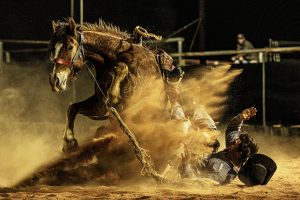
Nick was also a 2024 Sport Photography award finalist for his shot: Birdsville Rodeo. Photo: Sydney Morning Herald
James: Your photos, while visually stunning, appear to portray a sense of fear. Is that intentional?
Nick: In all the pictures I take I have tried to show a sense of smallness. People might themselves feel the fear of being in front of these disastrous events. But the idea is to convey the atmosphere that controls fires and storms. When the atmosphere takes over, it doesn’t matter what we do, it’s really just a matter of getting out of the way. It’s all in the preparation. You either get out of its way or suffer the consequences.
James: Should Australia be concerned about another severe fire season in 2024/2025?
Nick: My concern is for the south coast of New South Wales. At the stage, it’s well under the rainfall it’s supposed to have had, and even in Sydney it’s uncertain as we’ve had these heavy rain events, but it’s quite dry for a lot of the time before and after. We’re not going to get another 2019 ‘fire season’ in 2025, but we need to be cautious.
James: What tips do you have for any young photographers looking to get into disaster photography?
Nick: Research and get out there and find your content. Find people that know what they are doing. Most of the time I am very happy to have people come along with me, they just need to ask… I usually always say ‘Come out with me’. You’ve got to be there to witness these events with people who understand the risks.
—–
